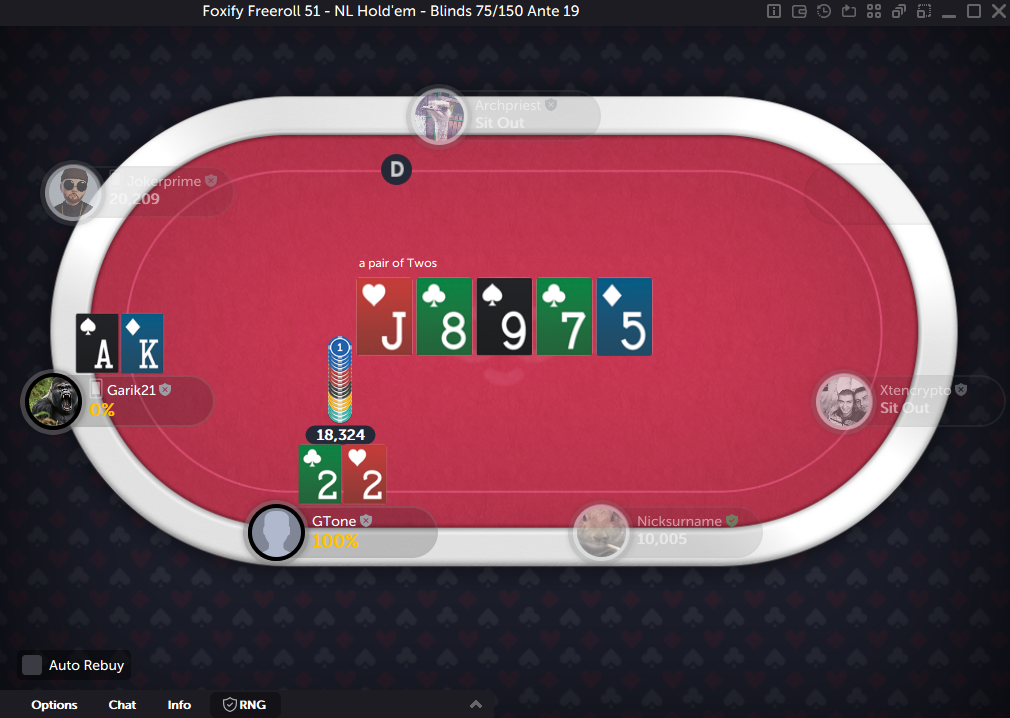Last Updated: 25 December 2024
ICM Poker: A Guide to the Independent Chip Model
Learn all about ICM poker using the Independent Chip Model and see what this modern tournament concept can do to improve your results at the table.
StrategyHave you ever wondered why the world’s best tournament players make what seem like crazy folds with premium hands? Or why having a massive chip lead doesn’t guarantee you’ll win the biggest slice of the prize pool? Welcome to the fascinating world of ICM poker, where traditional poker math gets flipped on its head.
In the upper echelons of tournament poker, understanding true equity becomes the key to success. At CoinPoker, we’re here to demystify this crucial tournament concept and show you exactly how mastering ICM can dramatically improve your results and help you make better decisions when it matters most.
What is ICM in Poker?
ICM in poker stands for Independent Chip Model. Unlike cash games, where a $1 chip is always worth exactly $1, tournament chip value constantly fluctuates. ICM helps you understand what your chips are actually worth in real money at any point in the tournament.
Picture this: You’re at a final table with 1,000 chips, and another player has 100 chips. In a cash game, you’d have 10 times their poker equity—simple math. But in a tournament, those 100 chips might be worth nearly as much as your 1,000 because that player can still climb up the payouts. This is where ICM comes in, helping you make decisions based on real money value rather than just chip poker chip counts.
Developed in 1987, ICM has become an essential part of poker tournament strategy for any serious tournament player, transforming how we approach decisions from the first hand to the final table.

When Should You Use ICM?
While many players think ICM only matters during bubble play and final tables, it actually impacts every tournament decision. Like gravity, it’s always there, but becomes most noticeable at critical moments.
ICM is particularly important:
- During bubble play and money jumps
- At final tables with significant pay increases
- In satellite tournaments with equal prizes
- When risking your entire stack
- When facing large stack disparities
Pay attention to opponents’ stack sizes and the payout structure. Even early in tournaments, ICM influences optimal play, especially when dealing with very short or large stacks at your table.

How Does ICM Poker Work?
ICM calculates your tournament equity by considering two critical factors: the chip stacks of all remaining players and the tournament’s payout structure. Think of it like a complex probability calculator that determines your chances of finishing in each paying position, then converts those probabilities into a real money value. This mathematical model helps bridge the gap between your current chip stack and your actual tournament equity.
The process of calculating ICM works through these steps:
- Evaluates your current chip stack relative to the total chips in play
- Calculates your probability of finishing in each paying position
- Multiplies those probabilities by the prize money for each position
- Considers the impact of stack sizes behind you
- Accounts for the tournament structure and payout distribution
- Combines all these factors to determine your total equity
For example, imagine you’re in a tournament with three players left. Just because you have half the chips in play doesn’t mean you’ll get half the prize money. Your actual tournament equity will be different because ICM considers both your chip stack and your chances of finishing in each paying position.
Understanding cEV and $EV
In poker tournaments, players must constantly balance two different types of expected value: chip expected value (cEV) and dollar expected value ($EV). Think of cEV as your short-term poker math—what play wins you the most chips right now. $EV, on the other hand, is like your long-term investment advisor—it tells you what decision makes you the most money over time.
This example shows how cEV and $EV work:
You’re on the bubble of a tournament with AK and a healthy stack of chips. A short stack, who you easily goes all-in . In terms of cEV, calling might be clearly profitable—you’re a favorite against their poker hand range and stand to win a huge amount of chips. However, when you factor in ICM and consider $EV, the risk of busting and missing out on guaranteed money might make this a clear fold. The chips you could win don’t justify the risk of losing your tournament life.
Key differences between cEV and $EV:
| cEV (Chip Expected Value) | $EV (Dollar Expected Value) |
| Focuses solely on chip accumulation | Considers real money implications |
| Remains constant throughout the tournament | Changes based on tournament stage and stack sizes |
| Calculations are straightforward | Requires complex ICM considerations |
| Guides cash game decisions | Dominates tournament strategy |
Understanding this distinction helps explain why strong tournament players often make decisions that might seem overly tight to cash game specialists. They’re playing for maximum $EV, not maximum cEV.
Advantages and Disadvantages of ICM in Poker
Before diving deeper into ICM strategy, let’s examine the complete picture of how this mathematical model affects your tournament play. While ICM provides an invaluable framework for making better decisions, it’s important to understand both its strengths and limitations to use it effectively.
| Advantages | Disadvantages |
| Provides clear mathematical framework for decisions | Doesn’t account for skill edges between players |
| Helps avoid costly mistakes near bubble | Can lead to overly tight play in some spots |
| Perfect for calculating fair deal numbers | Doesn’t consider future game flow or blind increases |
| Removes emotion from key decisions | Complex to calculate accurately in real-time |
| Improves satellite tournament play | May miss profitable spots if followed blindly |
| Essential for professional tournament play | Requires significant study to master |
| Helps maximize ROI in tournaments | Can be overwhelming for beginners |
| Makes bubble play more profitable | Might lead to exploitable tendencies if overused |
Understanding these trade-offs helps you implement ICM principles more effectively while avoiding common pitfalls that can trap players who rely too heavily on pure mathematical models.
How to Calculate ICM in Poker
Let’s break down ICM with a simple example that shows exactly how your chips translate to real money in a tournament.
Picture a three-player tournament with $1,000 in prizes:
- First place gets $500
- Second place gets $300
- Third place gets $200
You have half the chips in play. In a cash game, this would mean you have $500 in equity (half of $1,000). But tournament poker is different. Let’s see the actual calculation:
Your chances with half the chips:
- 45% chance of finishing first: 45% × $500 = $225
- 35% chance of finishing second: 35% × $300 = $105
- 20% chance of finishing third: 20% × $200 = $40
Add these up: $225 + $105 + $40 = $370
Your actual tournament equity is $370—significantly less than the $500 your chips might suggest. This is ICM in action, showing why you can’t just count chips to know your real tournament value.

Using ICM Calculator Tools
Think of an ICM calculator as a currency converter for poker tournaments. It has one job: telling you what your chips are worth in real money at any point in a tournament.
You’ll find these calculators most helpful when making deals at final tables, deciding whether to risk your stack near the bubble, or figuring out what your chips are really worth when pay jumps are coming up.
These days, poker training tools have taken ICM to the next level. Popular software like ICMIZER and HoldemResources Calculator combine ICM math with practice features, letting you train and improve your tournament decision-making.
How to Use ICM in Poker
Let’s walk through how to apply ICM thinking in a real tournament situation with five players left and significant pay jumps ahead:
- Assess Your Position Calculate your share of chips and note everyone’s stack sizes. If you have 40% of chips with four shorter stacks behind you, you’re in a strong but delicate position.
- Identify the Danger Stacks Medium stacks are often your biggest concern. They have enough chips to damage you but also have to worry about pay jumps. In our example, the 25% stack directly to your left is your main threat.
- Evaluate Pay Jumps Look at the difference between places. If 5th pays $100 but 4th pays $300, that $200 jump affects everyone’s decisions, especially shorter stacks.
- Adjust Your Ranges When facing an all-in, factor in both your chip equity and the pay jumps. With your 40% stack, you might fold AQ to a 10% stack’s all-in if another 10% stack is at risk of busting.
- Apply Pressure Wisely Use your big stack against the medium stacks when they can’t afford to call. But avoid unnecessary risks against the shortest stacks who are desperate to double.
This practical approach to ICM helps you make better decisions without needing complex calculations at the table.
ICM Poker Strategy for Different MTT Stages
Tournament strategy varies dramatically based on the stage of the event, with ICM considerations evolving as you progress deeper. Let’s break down how ICM influences your decisions throughout a tournament’s lifecycle.
ICM Poker in Early Stages
Early in tournaments, ICM has its smallest impact but shouldn’t be ignored completely. Focus on these key aspects to build a strong foundation for later stages:
- Building a stack through solid fundamental play
- Taking calculated risks to accumulate chips
- Being aware of stack sizes behind you
- Avoiding unnecessary confrontations with big stacks
- Looking for spots to pressure short stacks
- Maintaining healthy stack-to-blind ratio
- Identifying good accumulation opportunities
- Keeping track of average stack size
While ICM has less influence early, smart players still consider it when making major decisions that could affect their tournament life.
ICM Poker in Middle Stages
As you approach the bubble, ICM considerations become increasingly important:
- Pay closer attention to approaching pay jumps
- Increase aggression against medium stacks
- Avoid high-variance spots without clear edges
- Look for opportunities to pressure bubble stacks
- Maintain stack size relative to the tournament average
- Build chips through low-risk situations
- Target opponents who show bubble sensitivity
- Position yourself for late-stage success
The middle stages often determine whether you’ll have the stack to make moves when ICM pressure becomes most significant.
ICM Poker on the Bubble and Late Stages
The bubble is where ICM has its strongest influence, requiring careful attention to these factors:
- Tighten up significantly when at risk
- Apply maximum pressure to short/medium stacks
- Avoid marginal spots that could bust you
- Consider pay jumps in all decisions
- Look for opportunities to ladder up
- Exploit opponents’ bubble fear
- Manage your stack for optimal positioning
- Capitalize on ICM pressure against others
ICM Poker Strategy for Different Stack Sizes
Your stack size dramatically affects how ICM should influence your decisions. Let’s explore the optimal strategy for each position.
Short Stack ICM Strategy
When short-stacked, your primary focus should be finding profitable push/fold spots where you can double through bigger stacks. Be selective with your all-in calls, only playing premium hands. Pay close attention to the stacks behind you and be willing to fold strong hands in marginal spots, especially when pay jumps are approaching.
Medium Stack ICM Strategy
With a medium stack, preservation becomes key, especially on bubbles. Avoid unnecessary confrontations with big stacks while looking for spots to pressure other medium stacks. Focus on low-risk accumulation opportunities and target shorter stacks when possible, always keeping upcoming pay jumps in mind.
Big Stack ICM Strategy
As a big stack, you’re in a position to apply constant pressure, particularly against medium stacks which have the most to lose. While you should maintain aggression against vulnerable stacks, avoid unnecessary risks against other big stacks. Use your stack as a weapon on bubbles and control pot sizes based on your opponents’ depths.
What is an ICM Chop in Poker?
An ICM chop represents one of the most practical applications of the Independent Chip Model, occurring when remaining players in a tournament agree to end the event and split the prize money according to their ICM equity. Think of it as cashing out your chip equity for its current real money value, avoiding the variance of playing out the tournament.
Let’s see how an ICM chop works. Three players are left in a $10,000 tournament:
- First: $5,000
- Second: $3,000
- Third: $2,000
Their chip counts show Player A with 50%, Player B with 30%, and Player C with 20%. After running the ICM calculations, they agree to chop:
- Player A: $4,200
- Player B: $3,300
- Player C: $2,500
The tournament ends, and each player collects the share they agree to.
Find Tournaments to Practice ICM Strategy
Ready to put your ICM knowledge to work? CoinPoker offers an extensive range of tournaments that are perfect for applying and refining your ICM skills. From micro-stakes events to high-roller tournaments, you’ll find plenty of opportunities to practice these concepts in real-world situations.
Sign up to CoinPoker now to start applying your ICM knowledge and take your tournament game to the next level. With regular tournaments running around the clock, you’ll always find the perfect spot to implement your new ICM strategy.
FAQs
ICM stands for Independent Chip Model, a mathematical model used to convert tournament chips into real money equity based on remaining payouts and stack sizes.
ICM pressure refers to the added fold equity you have against opponents who must consider pay jumps and survival rather than just chip equity when making decisions. This pressure tends to be strongest on the bubble and during significant pay jumps.
No, ICM only applies to tournaments and sits-n-gos where there are multiple payouts. In cash games, chips always maintain the same value since you can cash out at any time.
While possible, calculating ICM manually involves complex probability calculations that are impractical during play. Most players use ICM calculators or develop good instincts through study and experience.
While ICM affects all tournament decisions, it’s most crucial during bubble play, at final tables, and whenever facing decisions that could eliminate you near pay jumps. Pay special attention when there are significant stack imbalances at your table.
Explore More
Announcements
Read recent announcements from CoinPoker about new games, ambassadors, and changes to our platform.
8 PostsGuides
The go-to resource for mastering poker with expert tips and strategies. Whether you're a beginner or a pro, our guides will elevate your skill level.
60 PostsNews
Find the latest poker news from CoinPoker, plus our latest CoinPoker Weekly and Monthly Newsletters. Updates about games, promotions and other exciting crypto news.
90 PostsPromotions
Find the latest coinpoker promotions here. Explore the crypto poker world with the best poker promotions available.
1 Post
















